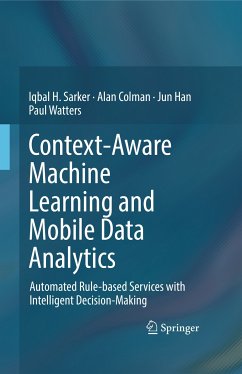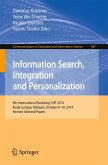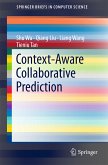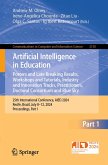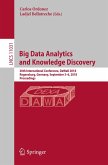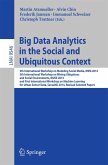Context-Aware Machine Learning and Mobile Data Analytics (eBook, PDF)
Automated Rule-based Services with Intelligent Decision-Making


Alle Infos zum eBook verschenken

Context-Aware Machine Learning and Mobile Data Analytics (eBook, PDF)
Automated Rule-based Services with Intelligent Decision-Making
- Format: PDF
- Merkliste
- Auf die Merkliste
- Bewerten Bewerten
- Teilen
- Produkt teilen
- Produkterinnerung
- Produkterinnerung

Hier können Sie sich einloggen

Bitte loggen Sie sich zunächst in Ihr Kundenkonto ein oder registrieren Sie sich bei bücher.de, um das eBook-Abo tolino select nutzen zu können.
This book offers a clear understanding of the concept of context-aware machine learning including an automated rule-based framework within the broad area of data science and analytics, particularly, with the aim of data-driven intelligent decision making. Thus, we have bestowed a comprehensive study on this topic that explores multi-dimensional contexts in machine learning modeling, context discretization with time-series modeling, contextual rule discovery and predictive analytics, recent-pattern or rule-based behavior modeling, and their usefulness in various context-aware intelligent…mehr
- Geräte: PC
- ohne Kopierschutz
- eBook Hilfe
- Größe: 2.92MB
![Information Search, Integration and Personalization (eBook, PDF) Information Search, Integration and Personalization (eBook, PDF)]() Information Search, Integration and Personalization (eBook, PDF)40,95 €
Information Search, Integration and Personalization (eBook, PDF)40,95 €![Context-Aware Collaborative Prediction (eBook, PDF) Context-Aware Collaborative Prediction (eBook, PDF)]() Shu WuContext-Aware Collaborative Prediction (eBook, PDF)40,95 €
Shu WuContext-Aware Collaborative Prediction (eBook, PDF)40,95 €![Artificial Intelligence in Education. Posters and Late Breaking Results, Workshops and Tutorials, Industry and Innovation Tracks, Practitioners, Doctoral Consortium and Blue Sky (eBook, PDF) Artificial Intelligence in Education. Posters and Late Breaking Results, Workshops and Tutorials, Industry and Innovation Tracks, Practitioners, Doctoral Consortium and Blue Sky (eBook, PDF)]() Artificial Intelligence in Education. Posters and Late Breaking Results, Workshops and Tutorials, Industry and Innovation Tracks, Practitioners, Doctoral Consortium and Blue Sky (eBook, PDF)105,95 €
Artificial Intelligence in Education. Posters and Late Breaking Results, Workshops and Tutorials, Industry and Innovation Tracks, Practitioners, Doctoral Consortium and Blue Sky (eBook, PDF)105,95 €![Artificial Intelligence in Education (eBook, PDF) Artificial Intelligence in Education (eBook, PDF)]() Artificial Intelligence in Education (eBook, PDF)89,95 €
Artificial Intelligence in Education (eBook, PDF)89,95 €![Big Data Analytics and Knowledge Discovery (eBook, PDF) Big Data Analytics and Knowledge Discovery (eBook, PDF)]() Big Data Analytics and Knowledge Discovery (eBook, PDF)40,95 €
Big Data Analytics and Knowledge Discovery (eBook, PDF)40,95 €![Big Data Analytics in the Social and Ubiquitous Context (eBook, PDF) Big Data Analytics in the Social and Ubiquitous Context (eBook, PDF)]() Big Data Analytics in the Social and Ubiquitous Context (eBook, PDF)40,95 €
Big Data Analytics in the Social and Ubiquitous Context (eBook, PDF)40,95 €![Artificial Intelligence in Education. Posters and Late Breaking Results, Workshops and Tutorials, Industry and Innovation Tracks, Practitioners, Doctoral Consortium and Blue Sky (eBook, PDF) Artificial Intelligence in Education. Posters and Late Breaking Results, Workshops and Tutorials, Industry and Innovation Tracks, Practitioners, Doctoral Consortium and Blue Sky (eBook, PDF)]() Artificial Intelligence in Education. Posters and Late Breaking Results, Workshops and Tutorials, Industry and Innovation Tracks, Practitioners, Doctoral Consortium and Blue Sky (eBook, PDF)97,95 €
Artificial Intelligence in Education. Posters and Late Breaking Results, Workshops and Tutorials, Industry and Innovation Tracks, Practitioners, Doctoral Consortium and Blue Sky (eBook, PDF)97,95 €-
-
-
Dieser Download kann aus rechtlichen Gründen nur mit Rechnungsadresse in A, B, BG, CY, CZ, D, DK, EW, E, FIN, F, GR, HR, H, IRL, I, LT, L, LR, M, NL, PL, P, R, S, SLO, SK ausgeliefert werden.
- Produktdetails
- Verlag: Springer International Publishing
- Seitenzahl: 157
- Erscheinungstermin: 1. Januar 2022
- Englisch
- ISBN-13: 9783030885304
- Artikelnr.: 63226633
- Verlag: Springer International Publishing
- Seitenzahl: 157
- Erscheinungstermin: 1. Januar 2022
- Englisch
- ISBN-13: 9783030885304
- Artikelnr.: 63226633
- Herstellerkennzeichnung Die Herstellerinformationen sind derzeit nicht verfügbar.
